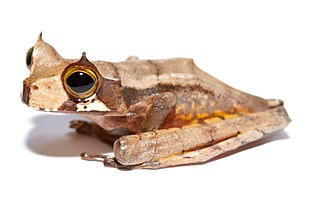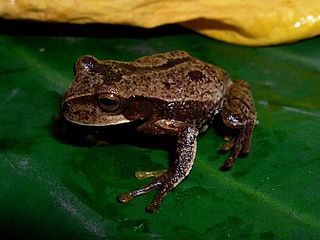
Gastrotheca is a genus of frogs in the family Hemiphractidae. They are found in Central America south of Costa Rica and in South America. Most species occur in the American Cordillera from southern Costa Rica to north-western Argentina. This genus makes up the bulk of marsupial frog diversity; formerly it was placed in the "Leptodactylidae" assemblage.

The elegant stubfoot toad or Pacific jambato frog is a species of toad in the family Bufonidae found in lowlands and Andean slopes of northwest Ecuador to 1,140 m (3,740 ft) asl and on the Gorgona Island, off southwest coast of Colombia. It was described by George Albert Boulenger in 1882 based on a specimen collected by Edward Whymper. It is known in Spanish as rana jambato del Pacífico or simply jambato del Pacífico.
Hyloxalus breviquartus is a species of frog in the family Dendrobatidae. It is found in the northern part of Cordillera Occidental in Antioquia, Colombia, and in Carchi Province in northwestern Ecuador. Colombian distribution may be wider. Its natural habitats are montane forests next to streams and very humid premontane forests. It is threatened by habitat loss, although it occurs in the Las Orquídeas National Natural Park, its type locality.
Hyloxalus lehmanni is a species of frog in the family Dendrobatidae. It is found widely in Colombia from Antioquia southwards to northern Ecuador.
Strabomantis cheiroplethus is a species of frog in the family Strabomantidae. It is endemic to Colombia and found on the western slopes of the northern half of the Cordillera Occidental.

Pristimantis buckleyi is a species of frog in the family Strabomantidae. It is found on the Andes of Colombia and Ecuador. Specifically, it occurs on the both flanks of the Cordillera Central and on the eastern flank of the Cordillera Occidental in Colombia, and on the Cordillera Real in Ecuador south Cayambe, at elevations of 2,500–3,700 m (8,200–12,100 ft) asl.
Pristimantis cabrerai is a species of frog in the family Strabomantidae. It is endemic to Colombia and is known from the Cordillera Occidental in Antioquia and Caldas Departments. Although common name Valle robber frog has been suggested for it, the specimen from Valle del Cauca is no longer assigned to this species.

Pristimantis curtipes is a species of frog in the family Strabomantidae. It is found in the Nariño Department of southern Colombia and in the Andes of Ecuador south to Desierto de Palmira.
Pristimantis illotus is a species of frog in the family Strabomantidae. It is found on the Cordillera Occidental in Valle del Cauca and Cauca Departments in Colombia and southwards to the Pichincha Province, Ecuador.
Niceforonia mantipus, the mantipus robber frog, is a species of frog in the family Strabomantidae. It is endemic to Colombia and found on the Cordillera Occidental and Cordillera Central, 800–2,400 m (2,600–7,900 ft) asl. Its natural habitats are cloud forests and secondary forests. It lives in leaf-litter and on ground. It is threatened by habitat loss.
Gastrotheca antomia is a species of frog in the family Hemiphractidae. It is endemic to Colombia and found on the western versant of the Cordillera Occidental in Antioquia, Risaralda, Chocó, and Valle del Cauca Departments, at elevations of 1,140–2,500 m (3,740–8,200 ft) asl.

Gastrotheca argenteovirens is a species of frog in the family Hemiphractidae. It is endemic to Colombia and occurs in the Colombian Massif, Cordillera Central, and Cordillera Occidental in the Quindío, Tolima, Valle del Cauca, Cauca, and Nariño Departments. Common name Popayan marsupial frog has been coined for it.
Gastrotheca bufona is a species of frog in the family Hemiphractidae. It is endemic to Colombia and known from the Cordillera Central and Cordillera Occidental in Antioquia and Caldas Departments, at elevations of 1,430–2,200 m (4,690–7,220 ft) asl. The specific name bufona is derived from Spanish bufón, meaning a jester or clown, and refers to the frog's "gaudy" appearance.

The horned marsupial frog, originally named Nototrema cornutum (Boulenger) after the first describer George Albert Boulenger in 1898), is a species of frog in the family Hemiphractidae. It is an arboreal species found in Colombia, Costa Rica, Ecuador and Panama. Its natural habitats are tropical moist lowland forests and montane cloud forests. It is threatened by habitat loss.

Gastrotheca dunni is a species of frog in the family Hemiphractidae. It is endemic to the northern part of the Cordillera Occidental in northern Antioquia, Colombia. The specific name dunni honors Emmett Reid Dunn, an American herpetologist. Common name Dunn's marsupial frog has been coined for it.
Helena's marsupial frog is a species of frog in the family Hemiphractidae. It is endemic to the Páramo de Tamá on the Venezuelan-Colombian border and occurs in Apure and Táchira states of Venezuela and Norte de Santander Department on the Cordillera Oriental of Colombia. It is named after Helen Gaige, an American herpetologist.
Gastrotheca nicefori is a species of frog in the family Hemiphractidae. It is found in the Andes of Colombia, on the Andean slopes of northern Venezuela, and in the highlands of eastern and central Panama.

The silver marsupial frog is a species of frog in the family Hemiphractidae. It is endemic to the Pacific slopes of Andes in northern and central Ecuador. It is a nocturnal, arboreal inhabitant of cloud forests that can also be found in forest edge and secondary, degraded habitats. It is closely associated with arboreal bromeliads. It is threatened by habitat loss.
Gastrotheca trachyceps is a species of frog in the family Hemiphractidae. It is endemic to the Cauca Department, Colombia, and is known from its type locality, Cerro Munchique in the Cordillera Occidental, and Vereda Santa Elena (Popayán) in the Cordillera Central. The specific name trachyceps is said to be derived from Greek trachy meaning "rough" and Latin ceps meaning "head", in reference to the rough appearance of the head. The proper word in Latin for head, however, is caput. The common name Cerro Munchique marsupial frog has been coined for it.

Nannophrys guentheri is an extinct species of frog in the family Dicroglossidae. It was endemic to Sri Lanka. The species was first identified in 1882 by George Boulenger and named after the German-born British zoologist Albert Günther. It is not known where in Sri Lanka the specimens were found.










